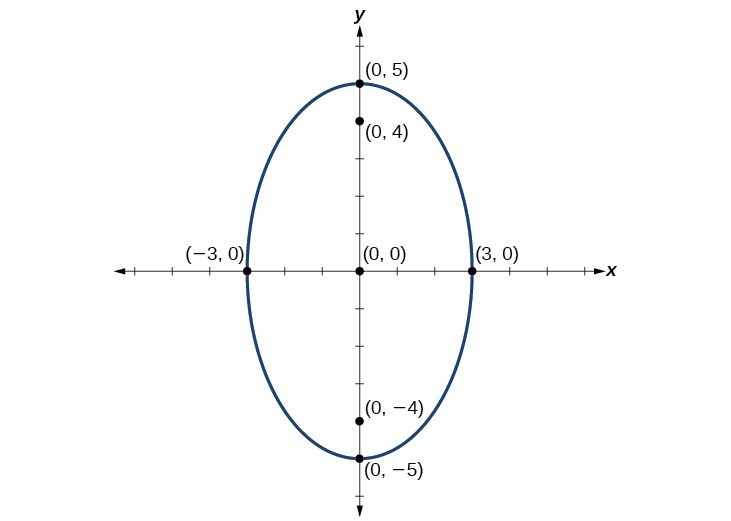Graphs of Ellipses
Learning Objectives
- Sketch a graph of an ellipse centered at the origin
- Sketch a graph of an ellipse not centered at the origin
- Express the equation of an ellipse in standard form given the equation in general form
How To: Given the standard form of an equation for an ellipse centered at [latex]\left(0,0\right)[/latex], sketch the graph.
- Use the standard forms of the equations of an ellipse to determine the major axis, vertices, co-vertices, and foci.
- If the equation is in the form [latex]\frac{{x}^{2}}{{a}^{2}}+\frac{{y}^{2}}{{b}^{2}}=1[/latex], where [latex]a>b[/latex], then
- the major axis is the x-axis
- the coordinates of the vertices are [latex]\left(\pm a,0\right)[/latex]
- the coordinates of the co-vertices are [latex]\left(0,\pm b\right)[/latex]
- the coordinates of the foci are [latex]\left(\pm c,0\right)[/latex]
- If the equation is in the form [latex]\frac{{x}^{2}}{{b}^{2}}+\frac{{y}^{2}}{{a}^{2}}=1[/latex], where [latex]a>b[/latex], then
- the major axis is the y-axis
- the coordinates of the vertices are [latex]\left(0,\pm a\right)[/latex]
- the coordinates of the co-vertices are [latex]\left(\pm b,0\right)[/latex]
- the coordinates of the foci are [latex]\left(0,\pm c\right)[/latex]
- If the equation is in the form [latex]\frac{{x}^{2}}{{a}^{2}}+\frac{{y}^{2}}{{b}^{2}}=1[/latex], where [latex]a>b[/latex], then
- Solve for [latex]c[/latex] using the equation [latex]{c}^{2}={a}^{2}-{b}^{2}[/latex].
- Plot the center, vertices, co-vertices, and foci in the coordinate plane, and draw a smooth curve to form the ellipse.
Example: Graphing an Ellipse Centered at the Origin
Graph the ellipse given by the equation, [latex]\frac{{x}^{2}}{9}+\frac{{y}^{2}}{25}=1[/latex]. Identify and label the center, vertices, co-vertices, and foci.Answer: First, we determine the position of the major axis. Because [latex]25>9[/latex], the major axis is on the y-axis. Therefore, the equation is in the form [latex]\frac{{x}^{2}}{{b}^{2}}+\frac{{y}^{2}}{{a}^{2}}=1[/latex], where [latex]{b}^{2}=9[/latex] and [latex]{a}^{2}=25[/latex]. It follows that:
- the center of the ellipse is [latex]\left(0,0\right)[/latex]
- the coordinates of the vertices are [latex]\left(0,\pm a\right)=\left(0,\pm \sqrt{25}\right)=\left(0,\pm 5\right)[/latex]
- the coordinates of the co-vertices are [latex]\left(\pm b,0\right)=\left(\pm \sqrt{9},0\right)=\left(\pm 3,0\right)[/latex]
- the coordinates of the foci are [latex]\left(0,\pm c\right)[/latex], where [latex]{c}^{2}={a}^{2}-{b}^{2}[/latex] Solving for [latex]c[/latex], we have:
[latex]\begin{array}{l}c=\pm \sqrt{{a}^{2}-{b}^{2}}\hfill \\ =\pm \sqrt{25 - 9}\hfill \\ =\pm \sqrt{16}\hfill \\ =\pm 4\hfill \end{array}[/latex]
Therefore, the coordinates of the foci are [latex]\left(0,\pm 4\right)[/latex]. Next, we plot and label the center, vertices, co-vertices, and foci, and draw a smooth curve to form the ellipse.
Try It
Graph the ellipse given by the equation [latex]\frac{{x}^{2}}{36}+\frac{{y}^{2}}{4}=1[/latex]. Identify and label the center, vertices, co-vertices, and foci.Answer:
center: [latex]\left(0,0\right)[/latex]; vertices: [latex]\left(\pm 6,0\right)[/latex]; co-vertices: [latex]\left(0,\pm 2\right)[/latex]; foci: [latex]\left(\pm 4\sqrt{2},0\right)[/latex]

Licenses & Attributions
CC licensed content, Original
- Revision and Adaptation. Provided by: Lumen Learning License: CC BY: Attribution.
CC licensed content, Shared previously
- College Algebra. Provided by: OpenStax Authored by: Abramson, Jay et al.. License: CC BY: Attribution. License terms: Download for free at http://cnx.org/contents/[email protected].
- Question ID 23514. Authored by: Shahbazian,Roy, mb McClure,Caren, mb Sousa,James. License: CC BY: Attribution. License terms: IMathAS Community License CC-BY + GPL.
CC licensed content, Specific attribution
- Precalculus. Provided by: OpenStax Authored by: OpenStax College. Located at: https://cnx.org/contents/[email protected]:1/Preface. License: CC BY: Attribution.
